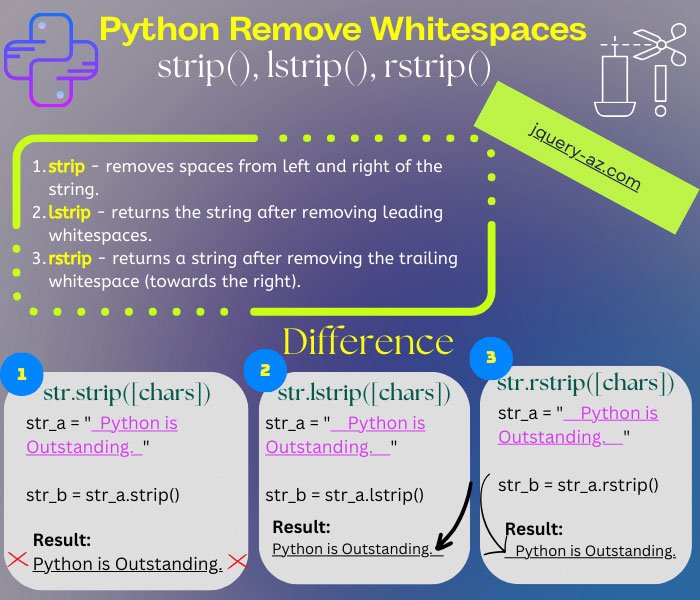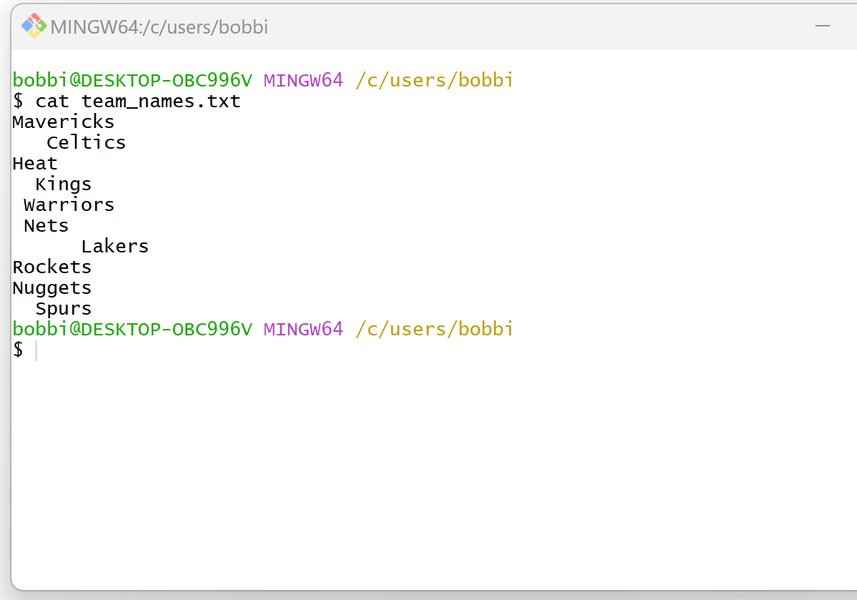
Mastering Whitespace Removal in Python Strings
A comprehensive guide to cleaning and manipulating text data efficiently.
Key Insights into Python String Cleaning
- Versatile Methods: Python offers a variety of built-in methods like
replace(),strip(),lstrip(), andrstrip(), alongside regular expressions, to effectively remove spaces from strings. - Targeted Removal: Depending on your specific needs, you can choose to remove all spaces, only leading/trailing spaces, or apply more complex patterns using regular expressions for nuanced control.
- Efficiency and Readability: Selecting the appropriate method depends on the desired outcome, with
replace()being excellent for universal space removal andstrip()family for boundary cleaning, ensuring both efficiency and clear code.
Dealing with whitespace is a common task in programming, especially when handling user input or processing text data. In Python, strings are immutable, meaning that any operation that "modifies" a string actually returns a new string with the changes applied. This guide delves into the various methods available in Python to effectively remove spaces from strings, ranging from simple replacements to more advanced regular expression techniques.
Understanding Whitespace in Python
Whitespace refers to any characters that represent horizontal or vertical space in text. In Python, common whitespace characters include:
- Space (
' ') - Tab (
'\t') - Newline (
'\n') - Carriage return (
'\r')
These characters can often appear in strings from various sources, such as user input, file parsing, or web scraping, and their removal is crucial for data cleaning, validation, and consistent processing.
Core Methods for Space Removal
The replace() Method: Eliminating All Spaces
The replace() method is perhaps the most straightforward way to remove all occurrences of a specific substring from a string. To remove all spaces, you simply replace each space character with an empty string.
my_string = "J a y d e n"
string_without_spaces = my_string.replace(" ", "")
print(string_without_spaces)
# Output: Jayden
This method is highly effective for universal space removal, regardless of where the spaces are located within the string (leading, trailing, or in-between). It's a simple and performant solution for basic space cleaning tasks.
The replace() method can also be used to remove other whitespace characters by specifying them as the first argument, for example, my_string.replace("\t", "") to remove tabs.
The strip() Family: Trimming Leading and Trailing Spaces
Python's strip(), lstrip(), and rstrip() methods are designed to remove whitespace characters from the ends of a string. They are particularly useful for cleaning up user input or data where leading or trailing spaces might cause issues.
strip(): Removing from Both Ends
The strip() method removes any leading (beginning) and trailing (end) whitespace characters from a string. By default, it removes spaces, tabs, newlines, and carriage returns.
text_with_extra_spaces = " Hello World "
trimmed_text = text_with_extra_spaces.strip()
print(trimmed_text)
# Output: "Hello World"
another_example = "\t\n Python Programming \n\t"
stripped_example = another_example.strip()
print(stripped_example)
# Output: "Python Programming"

Visual representation of how strip(), lstrip(), and rstrip() operate on strings.
lstrip(): Removing from the Left (Leading)
The lstrip() method specifically removes whitespace characters from the beginning (left side) of the string.
leading_spaces = " Leading space be gone!"
cleaned_string = leading_spaces.lstrip()
print(cleaned_string)
# Output: "Leading space be gone!"

An illustration demonstrating the removal of leading spaces using lstrip().
rstrip(): Removing from the Right (Trailing)
Conversely, the rstrip() method removes whitespace characters from the end (right side) of the string.
trailing_spaces = "Trailing space be gone! "
cleaned_string = trailing_spaces.rstrip()
print(cleaned_string)
# Output: "Trailing space be gone!"
Combining split() and join(): Handling Multiple Internal Spaces
For scenarios where you want to remove all spaces, or compress multiple spaces into a single space, the combination of split() and join() methods is highly effective. The split() method, when called without arguments, splits the string by any whitespace and discards empty strings, effectively treating multiple spaces as a single delimiter. Then, join() reassembles the parts.
sentence = "This is a sentence with extra spaces."
words = sentence.split() # Splits by any whitespace and handles multiple spaces
cleaned_sentence = " ".join(words) # Joins with a single space
print(cleaned_sentence)
# Output: "This is a sentence with extra spaces."
# To remove ALL spaces, join with an empty string:
all_spaces_removed = "".join(words)
print(all_spaces_removed)
# Output: "Thisisasentencewithextraspaces."
This method is particularly useful for normalizing strings by ensuring only single spaces separate words, or for completely eliminating all whitespace characters.
This video provides a clear explanation of how to use string.join() and .split() methods in Python to manage and remove unwanted spaces or concatenate lists. It dives into the mechanics of these powerful string manipulation techniques, which are essential for data cleaning and formatting.
Using Regular Expressions (re module): Advanced Whitespace Control
For more complex patterns of whitespace removal, or when dealing with various types of whitespace characters (spaces, tabs, newlines, form feeds, etc.), Python's re module (regular expressions) offers powerful capabilities.
import re
text_with_diverse_whitespace = " Hello\tWorld\n Python! "
# To remove all whitespace characters (space, tab, newline, etc.)
cleaned_text = re.sub(r'\s+', '', text_with_diverse_whitespace)
print(cleaned_text)
# Output: "HelloWorldPython!"
# To replace multiple spaces with a single space (and also trim leading/trailing)
single_spaced_text = re.sub(r'\s+', ' ', text_with_diverse_whitespace).strip()
print(single_spaced_text)
# Output: "Hello World Python!"
The pattern \s+ matches one or more whitespace characters. Using re.sub(r'\s+', '', text) effectively removes all whitespace, while re.sub(r'\s+', ' ', text).strip() compresses multiple spaces into single spaces and trims the ends.
Choosing the Right Method: A Comparative Analysis
The best method for removing spaces depends on the specific requirements of your task. Here's a comparison to help you decide:
This radar chart illustrates the strengths of different Python methods for string space removal across various criteria. A higher value (closer to the outer edge) indicates stronger performance or capability in that area. For instance, String.replace(" ", "") excels at simply removing all spaces and has low complexity, but doesn't handle leading/trailing or multiple internal spaces specifically. The strip() family is highly effective for boundary cleaning. String.split().join("") offers a balanced approach for both complete removal and normalizing internal spacing. Regular expressions (re.sub) provide the most comprehensive control for diverse whitespace patterns but introduce higher complexity.
Comparative Table of Methods
Below is a summary table comparing the various Python methods for removing spaces from strings, outlining their typical use cases, advantages, and limitations.
| Method | Description | Primary Use Case | Advantages | Limitations |
|---|---|---|---|---|
str.replace(" ", "") |
Replaces all occurrences of a specified substring with another. | Removing all occurrences of a specific character (e.g., all spaces). | Simple, efficient for complete removal, easy to understand. | Only removes specified character; doesn't handle other whitespace types or leading/trailing automatically. |
str.strip() |
Removes leading and trailing whitespace characters (spaces, tabs, newlines, etc.). | Cleaning external boundaries of a string (e.g., user input). | Concise, handles multiple whitespace types at ends by default. | Does not remove spaces or whitespace characters from the middle of the string. |
str.lstrip() |
Removes leading (left-side) whitespace characters. | Specific removal of whitespace from the beginning of a string. | Precise control over left-side trimming. | Only affects the left side; ignores trailing or internal spaces. |
str.rstrip() |
Removes trailing (right-side) whitespace characters. | Specific removal of whitespace from the end of a string. | Precise control over right-side trimming. | Only affects the right side; ignores leading or internal spaces. |
"".join(str.split()) |
Splits a string by any whitespace (multiple spaces treated as one) and joins the parts. | Removing all internal and external whitespace, or normalizing multiple spaces to single spaces. | Effective for complete removal or normalizing internal spaces; robust against various whitespace types. | Can be less intuitive for beginners; creates intermediate list. |
re.sub(r'\s+', '', str) |
Uses regular expressions to find and replace patterns. \s+ matches one or more whitespace characters. |
Complex pattern matching for diverse whitespace removal (e.g., replacing multiple spaces with one, removing all whitespace regardless of type). | Most powerful and flexible for advanced scenarios, handles all whitespace types. | Requires importing re module; regex syntax can be complex for simple tasks. |
Best Practices and Considerations
- Readability: For simple cases,
replace()and thestrip()family are highly readable. For more complex scenarios,split().join()or regular expressions might be necessary, but consider adding comments for clarity. - Performance: For basic tasks like removing all spaces,
replace()is often very efficient as it's implemented in C. For trimming ends,strip()is also highly optimized. Regular expressions, while powerful, might have a slight performance overhead for very large strings compared to simpler string methods. - Specific Needs: Always choose the method that precisely meets your requirement. Do you need to remove all spaces, only from the ends, or normalize internal spacing? Tailor your approach accordingly.
- Immutability: Remember that string methods in Python return new strings. You must assign the result of the operation back to a variable if you want to store the modified string.
# Incorrect: string remains unchanged
my_string = " hello "
my_string.strip() # Result of strip() is not assigned
print(my_string) # Output: " hello "
# Correct: assign the result
my_string = " hello "
my_string = my_string.strip() # Assign the new string
print(my_string) # Output: "hello"
Frequently Asked Questions
strip(), lstrip(), or rstrip() remove spaces from the middle of a string?strip() family of methods is specifically designed to remove characters only from the beginning and end of a string. They do not operate on characters found within the string. For internal space removal, methods like replace(), split().join(), or regular expressions are needed.str.replace(" ", "") and "".join(str.split()) for removing all spaces?str.replace(" ", "") explicitly replaces every single space character with nothing. "".join(str.split()) first splits the string by any whitespace (including tabs and newlines, and treating multiple consecutive spaces as one delimiter), then joins all the resulting parts back together without any separators. While both can remove all spaces, split().join() is more robust for general whitespace (tabs, newlines) and for compressing multiple spaces, whereas replace(" ", "") only targets the literal space character.re module) are ideal for advanced scenarios where you need to remove various types of whitespace characters (spaces, tabs, newlines, carriage returns, form feeds) or to handle more complex patterns, such as compressing multiple spaces into a single space, removing spaces only at specific positions, or dealing with non-standard whitespace. For simple tasks, built-in string methods are generally preferred for their readability and often better performance.replace() or strip() do not modify the original string in place. Instead, they return a new string with the modifications. To apply the changes, you must assign this new string to a variable, often overwriting the original variable.Conclusion
Python provides a rich set of tools for manipulating strings, including highly effective methods for removing spaces and other whitespace characters. Whether you need to eliminate all spaces, trim leading/trailing whitespace, normalize internal spacing, or handle complex patterns with regular expressions, there's a suitable method available. By understanding the specific capabilities and nuances of replace(), strip(), split().join(), and the re module, you can efficiently clean and prepare your string data for various programming tasks, ensuring robust and reliable applications.
Recommended Further Exploration
- Explore best practices for general string manipulation in Python.
- Dive deeper into advanced regular expression patterns for whitespace.
- Learn about performance considerations for string operations in Python.
- Understand the different types of Unicode whitespace characters in Python.